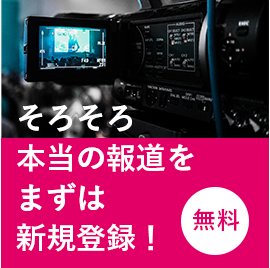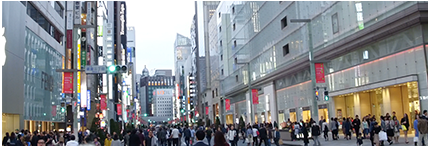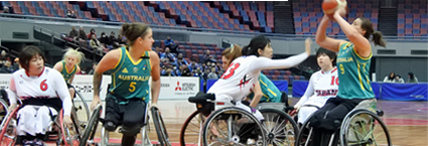A Report from Tomioka By AYANO KUBOTA
April 24, 2013
The voice of Ms. Ayano Kubota is regularly heard on the radio. She is herself a TV reporter as well. She is from Fukushima and since 2011, every Monday she works as an anchorperson for the Koriyama local radio program “Asa Koko”. She plays a proactive role in the coverage of issues related to Fukushima and is actively involved in the project “Voice of Fukushima”.
Voice of Fukushima, N. 4
Radiation Zone Realignment in Tomioka
With an estimated population of 16,000, Tomioka in the District of Futaba along the Pacific Ocean is a town located in the extreme east of Fukushima Prefecture. It is surrounded by mountains while Mt. Okura rises 593 meters high over the town. That’s why Tomioka is abundant in food from the sea and the mountains.
Another distinctive aspect of Tomioka is its mild climate. Almost no snowfalls are recorded in the town despite its location in Fukushima and the Tohoku area where winters are very cold. People who have once lived in the town unanimously declare that “there is no better place to live in.”
However, the Great East Japan Earthquake and the TEPCO Fukushima Daiichi Nuclear Power Plant accident have completely changed the town. Not only residents cannot live there anymore, until now almost nothing has been done to decontaminate, clean up the town, and fix collapsed buildings.
Meanwhile, two years after the disaster, the town was divided into three zones according to radiation levels. On April 1, 2013 operations for zone realignment were carried out in Tomioka.
1. The “Toward Evacuation Cancellation Zone” (9% of the population, about 1470 residents)
2. The “Residence Restricted Zone” where residents can return at daytime, but forbidden to stay there at night (62% of the population, about 9,800 residents)
3. The “Return Prohibited Zone” where residents are forbidden to return to their homes for a lengthy period of time (29% of the population, about 4,650 residents)
Most Tomioka residents are still prevented from returning to their homes.
[caption id="attachment_7994" align="alignleft" width="620"]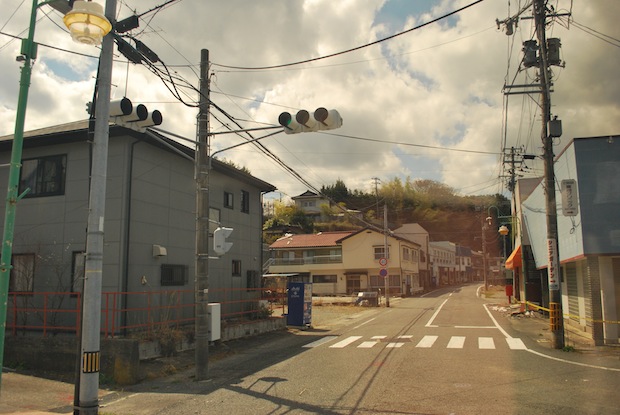 The air seems to stand still in the town[/caption]
The air seems to stand still in the town[/caption]
[caption id="attachment_7995" align="alignleft" width="620"]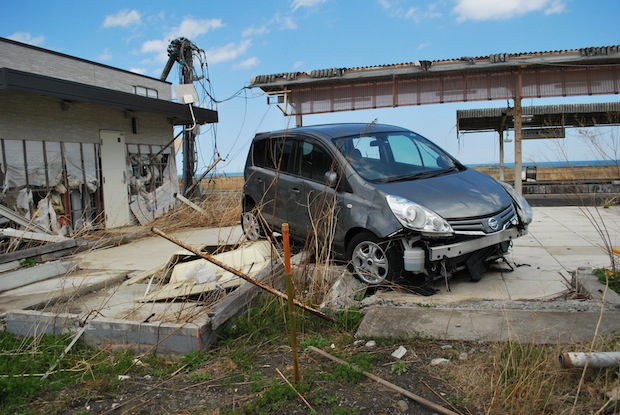 A Tsunami swept-away car abandoned at the train station platform[/caption]
A Tsunami swept-away car abandoned at the train station platform[/caption]
[caption id="attachment_7991" align="alignleft" width="620"]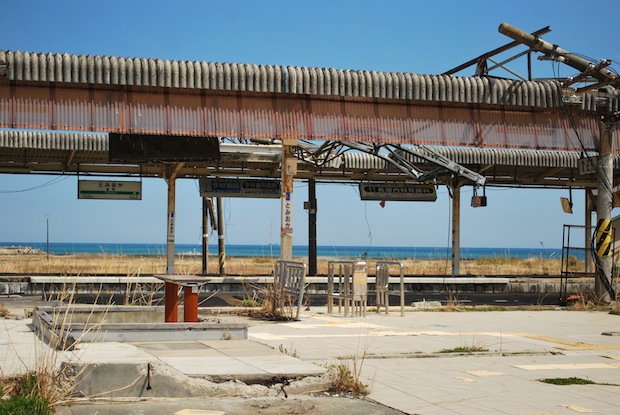 Tsunami-crippled Tomioka train station
Tsunami-crippled Tomioka train station
It’s possible to look out over the ocean now, but there used to be a lot of houses beyond the station.[/caption]
As of April, I became involved in temporary disaster related information radiocasting at the FM station of Tomioka. But I had never been to Tomioka. Before starting my work at the radio station, I wanted much to gauge the actual situation of the town two years after the catastrophe. In order to see for myself, I visited the town on April 11, 2013.
A local woman accompanied and guided me around. We reached Tomioka after a two-hour highway drive from Koriyama. Still in the mountain road, when my guide told me that “we are entering Tomioka now”, nothing appeared abnormal at first sight.
The town looked peaceful as anywhere in countryside Japan. It was a sunny and fine spring day. Clouds were floating in the vast and clear sky. The wind was a little chilly but gentle. Cherry blossoms all over the town were at their best, narcissuses and rapes were also blooming. It’s usually the season for the preparation of rice planting.
But as soon as we entered the residential area, everything dramatically changed. As a matter of course, not a soul could be seen at supermarkets, convenience stores, cafes, bars, at the municipal office, at schools, baseball grounds, tennis courts, and temples.
Rice fields were covered in weeds and pheasants were crowing here and there. A wild boar, perhaps coming from the nearby forest, was peacefully walking the prefectural road. A close look revealed that it was a pregnant mother boar. Abandoned cattle were grazing on the now weedy spaces of the residential area.
The whole town seemed like a static movie screen. It was so quiet that nobody could imagine that people used to live there. I realized how eerie a ghost town can be.
However, the absence of people did not stop animals and plants’ life cycle. Nature throve despite the crippled lifeline and the high amount of radioactivity. The natural realm only accommodates to new challenging conditions and perpetuates life.
Depending on the spot, radiation levels in Tomioka are diverse. At lower radiation level spots 1 to 2 microseiverts per hour are recorded, while in the “Return Prohibited Zone”, high radiation of 7 to 8 microsieverts per hour has been measured. Silvery barricades were erected to prevent people from entering the “Return Prohibited Zone”.
In order to enter the town rental hazmat suits were available, but my guide said: “Hazmat suits are not mandatory. There are people who do not bother to put on a hazmat suit because they intend to enter the town just for a short time. Others deem it precautious to wear a protective suit to prevent eventual health troubles in the future.”
That day I saw nobody wearing a hazmat suit among residents who were temporarily returning to their homes. On the other hand, security guards and decontamination workers were wearing protective suits. It was a contrasting scene! Restrictions on home return were enforced while the hazmat suit was optional.
I think that since the outbreak of the TEPCO Fukushima Daiichi Nuclear Power Station crisis, the victims have been requesting that guidelines be issued: the “Guideline on compensation”, the “Guideline on home return”, the “Guideline on the decommissioning of nuclear power plants”, and the “Guideline on life resettlement”.
A host of unintelligible regulations written in a difficult language and explained in an unclear way are being carried out. I wonder if TEPCO, the national and the local governments realize how Fukushima Prefecture residents are anxious about treading a path without guideposts.
[caption id="attachment_7992" align="alignleft" width="620"]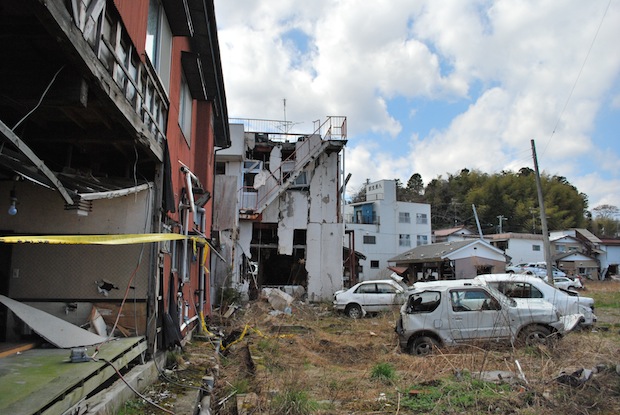 Quake destroyed buildings in front of Tomioka train station. The First Floor of the station was washed away by the tsunami. The area was badly affected by the tsunami.[/caption]
Quake destroyed buildings in front of Tomioka train station. The First Floor of the station was washed away by the tsunami. The area was badly affected by the tsunami.[/caption]
[caption id="attachment_7993" align="alignleft" width="620"]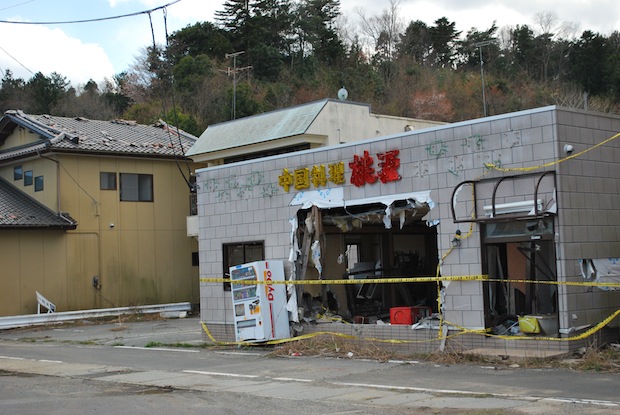 A Restaurant damaged by the tsunami. A resident said: “It was the ideal place in town for Chinese food”[/caption]
A Restaurant damaged by the tsunami. A resident said: “It was the ideal place in town for Chinese food”[/caption]
[caption id="attachment_7996" align="alignleft" width="620"]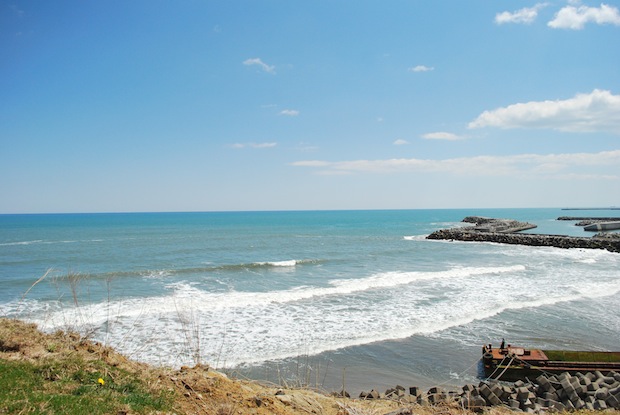 A View of the Pacific Ocean from Tomioka. My guide confided: “Even after such a disaster, I feel relieved when I contemplate the sea. I can’t resist it. Here I was brought up, closer to the ocean!”[/caption]
A View of the Pacific Ocean from Tomioka. My guide confided: “Even after such a disaster, I feel relieved when I contemplate the sea. I can’t resist it. Here I was brought up, closer to the ocean!”[/caption]
[caption id="attachment_7997" align="alignleft" width="620"] Radiation level in the car near the Return Prohibited Zone[/caption]
Radiation level in the car near the Return Prohibited Zone[/caption]
[caption id="attachment_7998" align="alignleft" width="620"] A house in the Return Prohibited Zone. A barricade prevents us from trespassing.[/caption]
A house in the Return Prohibited Zone. A barricade prevents us from trespassing.[/caption]
[caption id="attachment_7999" align="alignleft" width="620"] Return Prohibited Zone signboard and barricade[/caption]
Return Prohibited Zone signboard and barricade[/caption]
[caption id="attachment_8000" align="alignleft" width="620"] In Tomioka there’s a 2.5 km-long “tunnel” of cherry blossoms called “Yoru no Mori no Sakura”, literally “Nightly Forest of Cherry blossoms”. Residents are very proud of this row of cherry blossom trees and believe it’s the most beautiful cherry blossom viewing spot in Japan.[/caption]
In Tomioka there’s a 2.5 km-long “tunnel” of cherry blossoms called “Yoru no Mori no Sakura”, literally “Nightly Forest of Cherry blossoms”. Residents are very proud of this row of cherry blossom trees and believe it’s the most beautiful cherry blossom viewing spot in Japan.[/caption]
【VOICE OF FUKUSHIMA&NL Original】
※Radiocast of 「VOICE OF FUKUSHIMA」 at http://u3w.jp (in Japanese)
(c)Ayano Kubota/NOBORDER Inc.
(Translated from Japanese by Naoko Miyajima)



